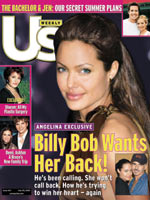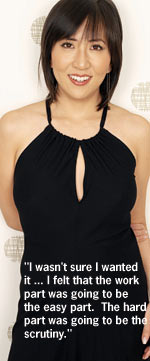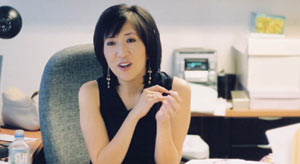|
|
 |
 |
 |
 |
|
COVER STORYMin Makes Her MarkUnder Janice Min ’90, Us Weekly has become a saucy, fun read - and Advertising Age's 2004 magazine of the year.By Sarah Lorge Butler ’95
Actress Cameron Diaz slugged a photographer and absconded with his camera, and thanks to Us Weekly’s November 22 issue, the world learned all about it — and saw pictures that proved it. The day the magazine hits newsstands, Us’s staffers have plenty to talk about as they file into a conference room at their midtown New York office to review the lineup for the next issue. Managing editor Jon Kline technically runs the meeting, but it’s editor-in-chief Janice Min ’90 who presides over the gathering. Min begins by asking if everyone has seen page three of the New York Post. The Post bought the Diaz meltdown photos from Us, giving an extra dose of exposure to the already much-talked-about weekly. Then this update: Not only has the camera in question been recovered, but the images, presumably showing a furious Diaz coming at the cameraman, are intact. The staff — mostly black-clad, mostly young, mostly female, mirroring the magazine’s readership — is buzzing. For a publication centered on celebrities and their lives, from the ridiculous to the sublime, Diaz caught on camera is big news. Or, as Us Weekly classifies it, Hot Stuff.
Talk turns to the upcoming issue. Kline asks reporters for updates; they direct their answers to Min. The features will cover a party hosted by Tori Spelling and TV’s fall hunks, along with coverage of J. Lo, Britney, Ben, Gwyneth and Jessica Simpson. Then Min raises the topic that everyone’s been waiting to discuss: how best to follow up on the article “Cameron’s Crazy Fight!” Ideas start flying, and the team, including Min, is laughing at the possibilities. A montage of celebrities attacking photographers? A pictoral history of Diaz’s past encounters with the paparazzi? Min quickly makes a decision: “OK, let’s see all the Cameron freak-out photos.” The writers and editors retreat to the newsroom to begin, once again, the demanding process of creating a weekly magazine for an audience of more than six million. Under Min’s leadership, they clearly are enjoying themselves. Says one staffer of the camaraderie: “It sort of has a homeroom feel to it.” Min, 35, landed at Us as executive editor to then-head honcho Bonnie Fuller in March 2002 after working at several publications, most notably People. As Us’s second-in-command, Min had been intimately involved in producing the magazine for more than a year, but she was as surprised as anyone to find herself atop the masthead in 2003. That June, she and her husband, Peter Sheehy ’90, were vacationing in Tuscany. One evening, as they ate dinner in a small restaurant, a waiter approached their table to tell Min she had a phone call. “Our hearts dropped to our stomachs,” Sheehy recalls, as they steeled themselves for bad news. Instead, on the line was Jann Wenner, chairman of Wenner Media, which owns Us and flagship publication Rolling Stone. He told a shocked Min that Fuller had quit to go to tabloid publisher American Media (one of Us’s competitors), and he offered Min the job. “She came back to the table, and there was no color in her face,” Sheehy remembers. “My initial reaction was, ‘I feel sick,’” says Min. “I wasn’t sure I wanted it. I had reservations, but when it came down to it, I thought, ‘I’ve been kind of doing it all along anyway.’ I felt that the work part was going to be the easy part. The hard part was going to be the scrutiny.” She was right about the scrutiny. Fuller had revamped Us and created a splashy success; her sudden departure generated considerable ink. An article in The New York Times quoted an anonymous Us staff member as wondering if Fuller “might have taken her magic touch with her,” and Daily Variety wrote, “The question is whether Min can pull it off without Fuller’s experience and adrenaline.” Not everyone at the magazine, however, was worried. “There was a lot of relief when Janice took over,” maintains executive editor Ken Baker ’94J. “She knew the magazine, she knew how to do it and she had been putting it together.” Baker’s confidence proved prescient. Under Min’s leadership, Us Weekly’s readership has grown by 22 percent and ad pages by 28 percent, according to industry monitoring sources. Newsstand sales show the most dramatic gains: During the Fuller era, the magazine averaged 507,000 weekly copies sold; that number has since risen to nearly 851,000. Readers are young and affluent, with a median household income of more than $72,000. In October, the industry publication Advertising Age named Us Weekly its 2004 magazine of the year. The pastel-laden Us Weekly oozes exclamation points and titillating headlines, such as “Ashley’s Older Man!” or “J. Lo Talks to Us: I’m Ready for a Baby!” The magazine uses specific terminology: Jewelry is “bling,” and couples don’t divorce, they “split.” Photos dominate the pages, depicting stars in any setting: going on vacation, attending the Oscars or fumbling for their car keys. While Us’s unmistakable format was created while Fuller helmed the magazine, Min has put her mark on it. “You can’t be a caretaker on any living magazine,” says Fuller of her former deputy. “Yes, the format was established, the formula was working. But Janice is doing an excellent job.” To create a magazine that is smart, saucy (Baker’s word) and tongue-in-cheek (Sheehy’s assessment) week after week, Min keeps a close eye on details, including headlines and photo captions. “It’s important to me to put my imprint on every story,” she says.
Min says that Us is focused on a young audience with a distinct sensibility. “I know sophisticated people who still like to read about celebrities,” Min says. “They want stories to be funny, well-written and informative.” Min cites a friend at Harvard Business School who tells her that those students love the magazine. “I think it is an incorrect assessment that educated people aren’t interested in celebrities,” Min notes. “They love the diversion and the entertainment value.” The mixture of celebrities looking both fabulous and ordinary can be addictive, and editors try to keep readers hanging. In November, Jessica Simpson graced the cover for three consecutive weeks. “Weekly journalism is like a soap opera, and the stars are the celebrities we cover,” Baker says. “Every week, it’s a new episode. In the old days, it was an unwritten rule that you couldn’t put the same person on the cover for 6–12 months. Well, who says you can’t?” The follow-up to the Diaz scuffle pondered, in a two-page spread, how her outburst affected her relationship with boyfriend Justin Timberlake. It was accompanied by three sidebars, including one headlined “Cameron Flips for the Camera,” a series of three shots depicting Diaz on separate occasions extending her middle finger to photographers. But all the silliness that Us promotes shouldn’t obscure the solid reporting behind each issue. “We’ve been able to bring a sense of journalism to celebrity news,” Min says. “It’s the first time anyone’s really done it. I’m proud that we’ve broken almost every big celebrity story [in 2004]: for example, J. Lo and Ben breaking up, twice, and J. Lo getting married. It’s great reporters covering their beats, working sources. No one is calling us and giving us this information.” Min’s ascent is due in large part to her sense of what resonates with readers. Us closes production on Monday, and Min focuses much of her energy on the cover. As each Monday begins, she and three executive editors have three possible cover stories in the works. They debate and tinker throughout the day, deciding which feature will be most compelling. It can be as late as 7 p.m. (the magazine is usually put to bed by midnight) before the cover is decided. Min, her staff says, will poll everyone — her assistant, her writers, her friends and subscribers via the Internet — for their opinions on various celebrities, but she often surprises them with her instincts for the hot story. Executive editor Nic McCarthy recalls one Monday when the news came in that Ben Affleck and Jennifer Garner were dating. “I remember Janice saying, ‘That’s it, that’s the cover,’” McCarthy says. “I wasn’t convinced yet. It was literally the minute it came in, and Janice was definite. And it was one of the year’s best-selling issues.” Baker remembers a similar experience when Min decided to feature Simpson and her husband, Nick Lachey, for the first time; that issue became one of the top five sellers. “This is an unusual form of magazine publishing,” says Kent Brownridge, general manager of Wenner Media and Min’s boss. “It’s an art to produce a magazine for this audience; it’s hard, and beyond fast-paced. You don’t have time to sit around and wring your hands; you just do it. Then when you’re done, you need to do the next one.” Min’s sense hasn’t been perfect; she’ll admit to mistakes, such as a cover that featured Martha Stewart after she was convicted. Stewart is simply too old to connect with Us’s readership. “There are times when I’ve ruled against what seemed to be the right decision and had enormous success on the cover,” Min says. “Other times, I ruled against everyone and did not have enormous success.” The newsstand sales figures show up a week after publication, so Min gets immediate feedback. She’s disappointed when a cover doesn’t sell well. “Janice is really competitive,” Brownridge says. “She likes to win.” As determined as she is now, Min says she wasn’t looking to win any academic awards at Columbia. It was New York that drew her to the College and its diversity that she loved. Min was raised in Littleton, Colo., about a mile from Columbine High School (though she did not attend it) and says that media portrayals of a homogenous community there were accurate. “The education I had my first 12 years of school couldn’t compare to the social — and I don’t just mean going out — experience of Columbia,” Min says. “It was an education in itself.” Min loved Kenneth Jackson’s “History of New York City” class and her Lit Hum section, but she was not a stellar student. She and Sheehy, who married in 1997, met during junior year, when they lived next door to each other in Wallach. They began dating as seniors and studied together for history classes. “If there was a test, I’d say, ‘OK, these are the three things we need to know,’” Min recalls. “He’d read the whole book 10 times over.” Sheehy is forever teasing her when she says they were both history majors, reminding her, “No, you were a history concentration.”
But Min’s friends aren’t surprised by her success — or that she’s heading a magazine with a focus on pop culture and fashion. These days, she favors Prada, but even at Columbia, Min’s fashion sense stood out. “She always had cute little bags that went with her shoes, and she wore miniskirts,” says Sarah Church ’90. “We were unlikely friends, because I was more of a hippie type and she always wore lipstick.” Since high school, Min wanted to pursue a career in journalism, another reason to attend college in New York. She interned one summer at what was then the MacNeil/Lehrer NewsHour, and in her senior year, she was accepted to the Journalism School, from which she graduated in 1991. Min’s first job was at a Gannett-owned daily in Westchester County, where she covered the police beat as well as school board and planning committee meetings before becoming a features writer. From there, she made the leap to People as a staff writer. Min worked her way up to senior editor, in charge of such beats as Princess Diana, JFK Jr., parties and animals. (The magazine’s “Hero Pets” fell under Min’s purview.) As Sheehy earned a Ph.D. in history from the University of Virginia, Min was his merciless dissertation editor. “Janice does not like academic prose,” he says. “I had to be careful that she didn’t put in too many puns.” In 1997, the year Princess Diana died, Min wrote or edited at least 20 People cover stories, an amazing show of stamina and speed. She also did stints at Life and In Style before Fuller lured her to Us, which was notorious at the time for its late closes. Monday nights routinely stretched until 4 or 5 a.m. on Tuesday before the magazine closed, but Min works well without a lot of sleep. “The first year was insanity, with grueling hours,” she says. “But I have a lot of endurance — I’m well suited to the weekly pace. If I don’t have a lot of activity, I get bored.”
The relentless schedule of a weekly means that work conversations spill over to the weekends, and Min and her three executive editors constantly e-mail each other on their BlackBerries. In June, when Min gave birth to her first child, Will, she was e-mailing Baker from the hospital while she was in labor. “I wrote, ‘Shouldn’t you be having a baby?’” Baker recalls. “And she wrote back something like, ‘Oh, I’m just lying here. It’s boring.’ ” In the office, Min navigates with aplomb (and a steady supply of Jamba Juice) mountains of copy, meetings with Wenner and Brownridge and frequent television appearances. “I’ve never seen Janice in a panic,” McCarthy says. “She’s unflappable.” She also downplays the job’s demands when talking to her Columbia friends. “She doesn’t make a big deal of it,” says Fred Erker ’90. “I’m thinking, ‘Running a magazine must be more difficult than she makes it out to be.’ ” Min has grown the magazine without alienating her staff, mindful that not everyone shares her endurance. “I think all editors have a compulsion to keep trying to make their magazine better until the last minute,” she says. “But I try to respect people’s time. I realize that even though everyone who works here seems to enjoy it, they also need to have lives. You reach a certain point of diminishing returns when you start to change things too much in the magazine. ‘Will it matter to the reader if I change this picture? Will it matter to the reader if I change this caption?’ These are the questions I weigh on a close night all the time.” Min’s focus on her employees — it’s as much about them as it is about Us — has earned her loyalty from the rank and file and kudos from the executive suite. “Her staff loves her,” Brownridge says. “And you forget how young she is. She’s just extremely good. Which isn’t to say you have to be old to be good, but after you work with somebody, you know them so well, you just forget everything. I just think of her as Janice. And she’s one of very few people in the country who are really good at this.” Sarah Lorge Butler ’95 is a mom, writer
and Red Sox fan
|
|
|||||||||||||||||||||||||||||||||||||||||||||||||||||||||||||||||||||



